
Russia is the largest country in the world, covering over 17,125,192 km2 (6,612,074 sq mi), and encompassing more than one-eighth of Earth's inhabited land area. Russia extends across eleven time zones, and has the most borders of any country in the world, with sixteen sovereign nations.

The early history of Siberia was greatly influenced by the sophisticated nomadic civilizations of the Scythians (Pazyryk) on the west of the Ural Mountains and Xiongnu (Noin-Ula) on the east of the Urals, both flourishing before the common era. The steppes of Siberia were occupied by a succession of nomadic peoples, including the Khitan people, various Turkic peoples, and the Mongol Empire. In the Late Middle Ages, Tibetan Buddhism spread into the areas south of Lake Baikal.
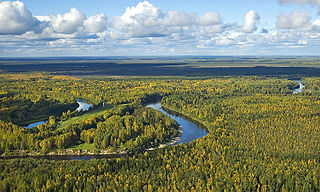
The West Siberian Plain is a large plain that occupies the western portion of Siberia, between the Ural Mountains in the west and the Yenisei River in the east, and the Altai Mountains on the southeast. Much of the plain is poorly drained and consists of some of the world's largest swamps and floodplains. Important cities include Chelyabinsk, Novosibirsk, Omsk, and Tomsk, as well as Surgut and Nizhnevartovsk.

The Central Siberian Plateau is a vast mountainous area in Siberia, one of the Great Russian Regions.
The Kuznetsk Basin in southwestern Siberia, Russia, is one of the largest coal mining areas in Russia, covering an area of around 10,000 square miles (26,000 km2). It lies in the Kuznetsk Depression between Tomsk and Novokuznetsk in the basin of the Tom River. From the south it borders the Abakan Range, from the west Salair Ridge, and Kuznetsk Alatau from the east.

Ural Economic Region is one of twelve economic regions of Russia. This prominent industrial region consists of the following subdivisions : Bashkortostan (Ufa), Chelyabinsk Oblast (Chelyabinsk), Kurgan Oblast (Kurgan), Orenburg Oblast (Orenburg), Perm Krai (Perm), Sverdlovsk Oblast (Yekaterinburg) and Udmurt Republic (Izhevsk). It is mostly located in the Central, and partly in the Southern and Northern parts of the Urals, but also includes parts of the East European and West Siberian Plains. Its extent is different from that of the Ural Federal District; Bashkortostan, Orenburg Oblast, Perm Krai and Udmurtia are in the Volga Federal District while the other three are in the Ural Federal District.

The Economy of the Empire of Japan refers to the period in Japanese economic history in Imperial Japan that began with the Meiji Restoration in 1868 and ended with the Surrender of Japan in 1945 at the end of World War II. It was characterized by a period of rapid industrialization in the late nineteenth and early twentieth centuries, and the dominance of a wartime economy from 1938 to 1945.

Mining in Japan is minimal because Japan does not possess many on-shore mineral resources. Many of the on-shore minerals have already been mined to the point that it has become less expensive to import minerals. There are small deposits of coal, oil, iron and minerals in the Japanese archipelago. Japan is scarce in critical natural resources and has been heavily dependent on imported energy and raw materials. There are major deep sea mineral resources in the seabed of Japan. This is not mined yet due to technological obstacles for deep sea mining.

Kuznetsk Alatau is a mountain range in southern Siberia, Russia. The range rises in the Altai-Sayan region of the South Siberian Mountains, northwest of Mongolia. The Siberian Railway skirts the northern limit of the range.
Coal mining regions are significant resource extraction industries in many parts of the world. They provide a large amount of the fossil fuel energy in the world economy.
The mineral industry of Russia is one of the world's leading mineral industries and accounts for a large percentage of the Commonwealth of Independent States' production of a range of mineral products, including metals, industrial minerals, and mineral fuels. In 2005, Russia ranked among the leading world producers or was a significant producer of a vast range of mineral commodities, including aluminum, arsenic, cement, copper, magnesium compounds and metals, nitrogen, palladium, silicon, nickel and vanadium.

The Bely Iyus is a river in the Republic of Khakassia in Russia. It is the right source river of the Chulym. It is 224 kilometres (139 mi) long, with a drainage basin of 5,370 square kilometres (2,070 sq mi).
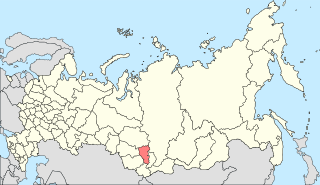
South Central Siberia is a geographical region north of the point where Russia, China, Kazakhstan and Mongolia come together.

The East Siberian Railway is a railway in Russia, which runs across Irkutsk Oblast, Chita Oblast, Buryatia, and Yakutia. The railway administration is located in Irkutsk. The East Siberian Railway borders with the Krasnoyarsk Railway, Trans-Baikal Railway, and Baikal Amur Mainline. To the south, the East Siberian Railway runs close to the Russo-Mongolian border. As of 2008, the total working length of the East Siberian Railway was 3,848.1 km (2,391.1 mi); number of employees – 46,233 ; net weight hauled – 76 million tonnes ; long-distance passenger traffic – 3.6 million people ; suburban traffic – 29 million people. Annual cargo turnover is 278 million tonnes.
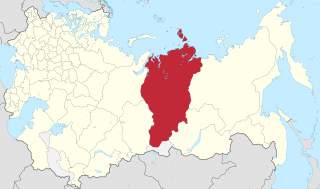
Yeniseysk Governorate was an administrative-territorial unit (guberniya) of the Russian Empire, the Russian Republic, and the Russian SFSR in 1822–1925. It was named after Yeniseysk.

The geology of Russia, the world's largest country, which extends over much of northern Eurasia, consists of several stable cratons and sedimentary platforms bounded by orogenic (mountain) belts.
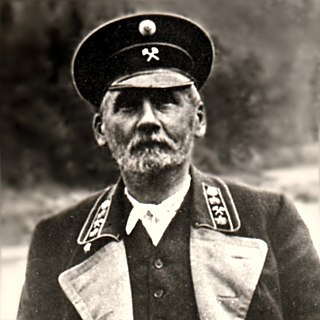
Leonard Jaczewski (Russian: Леонард Антонович Ячевский; Polish: Leonard Jaczewski; was a Polish geologist, geographer, engineer and explorer of Siberia. He was one of the pioneers in the study of permafrost.

The Sayan montane conifer forests ecoregion covers the mid-elevation levels of the Sayan Mountains, the high mountain range between the taiga of Siberia, Russia to the north, and the steppes of Mongolia to the south. The slopes of the mountains at the mid-altitudes are covered by Temperate coniferous forest. The ecoregion is in the Palearctic realm, with a cold semi-arid climate. It covers 35,741,835 km2 (13,800,000 sq mi).
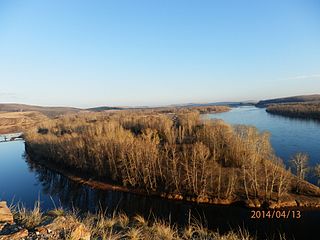
The South Siberian forest steppe ecoregion is a patchwork of grasslands and forests in the low-lying areas of south central Siberia. The region is one of high biodiversity as a transition zone between the West Siberian taiga to the north, and the Altai mountains to the south. There are also small patches to the east in Irkutsk Oblast. The ecoregion is in the temperate grasslands, savannas, and shrublands biome, and the Palearctic realm, with a Humid Continental climate. It covers 161,874 km2 (62,500 sq mi).

The South Siberian Mountains are one of the largest mountain systems of the Russian Federation. The total area of the system of mountain ranges is more than 1.5 million km². The South Siberian Mountains are located in the Siberian and Far Eastern Federal Districts of Russia, as well as partly in Mongolia. The territory of the mountain system is one of the Great Russian Regions.
















